One question we always get is about our favorite places to travel. While it’s a hard thing to answer, Italy is always part of our litany of responses. The hilltop views, the ancient sites imbued with tales of gods and emperors, the amazing wine for just a few euros, the hidden hot springs, and the Mediterranean sun–there’s everything to love about Italy. And it’s all true of Sicily, too. Because there are so many great places to choose from, it’s hard to narrow down the best cities in Sicily to visit.

Sicily is a huge island, which we didn’t fully appreciate until we began planning where to go. It is just a little smaller than the state of Massachusetts and the entire country of Albania. That’s a lot of ground to cover. And because many of the ancient sites were built near the coast, many of the top things to see are on the periphery of this triangle-shaped island.

Distances between towns in Sicily can be long on the outer edges of the island, but we were determined to see as many places as possible. Read on to see more about our favorite Sicily destinations.
Taormina

From its perch high on a hill in eastern Sicily, Taormina offers some of the best views on the island. Its centerpiece is its Ancient Theater, which dates from the 3rd century BC. From the top of the amphitheater, you can look out over the Mediterranean and the Sicilian coast speckled with terra cotta roofs. On a clear day (unfortunately, we had clouds), you can see Mount Etna rising in the background.
Taormina has been the most popular tourist destination and one of the best places to visit in Sicily for several centuries. Along with the theater, its medieval buildings, shops, and restaurants make it a popular cruise excursion and day trip. That means it gets crowded during the heart of the day, so it’s best to go early or late to avoid the crowds, which can be overwhelming as they snake through the ancient streets.
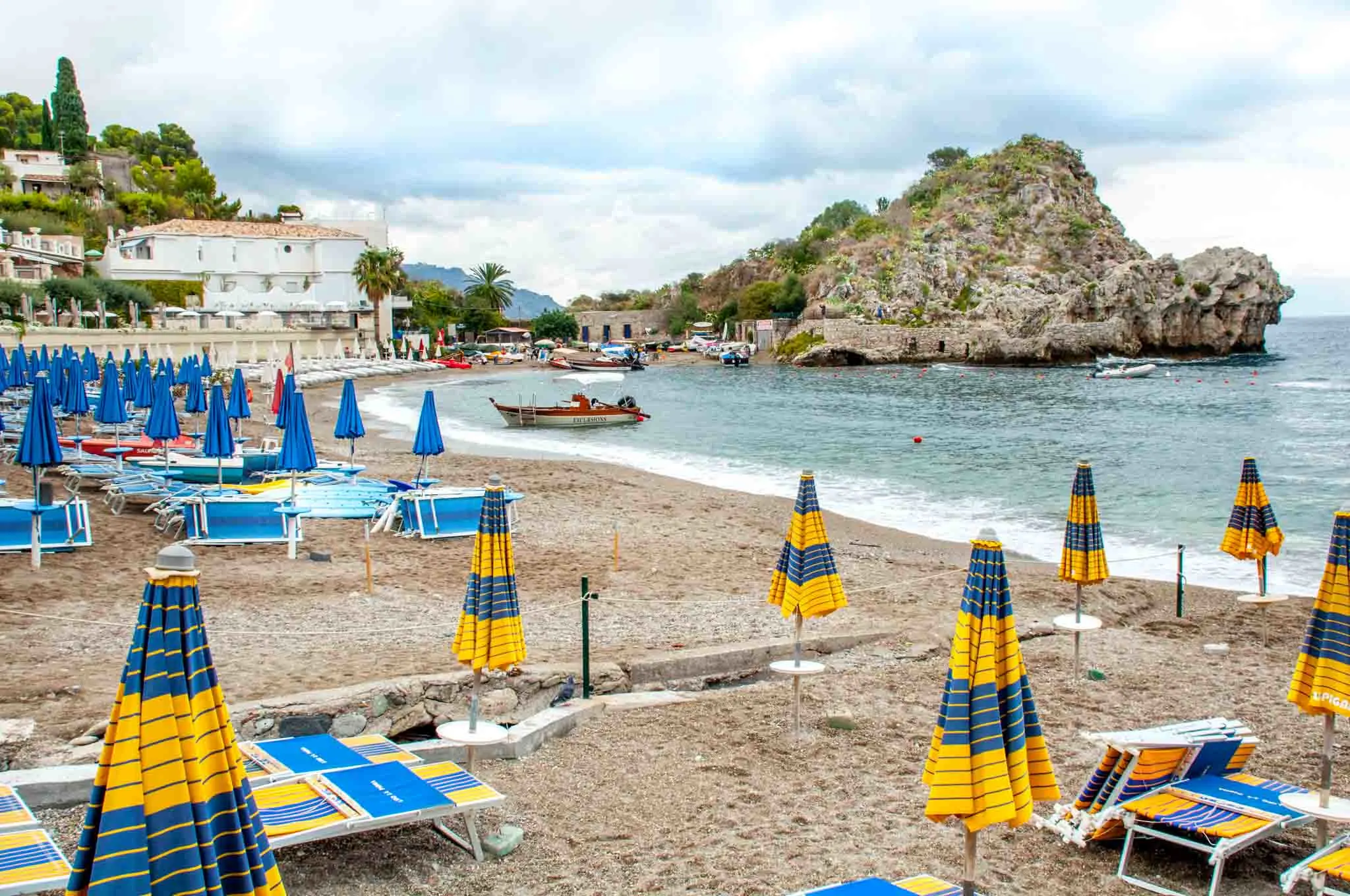
For a (sometimes) less congested environment, add the beach at the base of Taormina to your list.
Where to stay near Taormina
We based ourselves just five miles from Taormina in the town of Giardini Naxos. It was much easier to have a car there, and hotel rates were considerably less expensive than in Taormina.
- We stayed at the Unahotels Naxos Beach Sicilia, a sprawling complex with lovely gardens, pools, and beach access (Read reviews and book a room).
- The nearby Delta Hotels Giardini Naxos is also a good option (Read reviews and book a room).
Vulcano
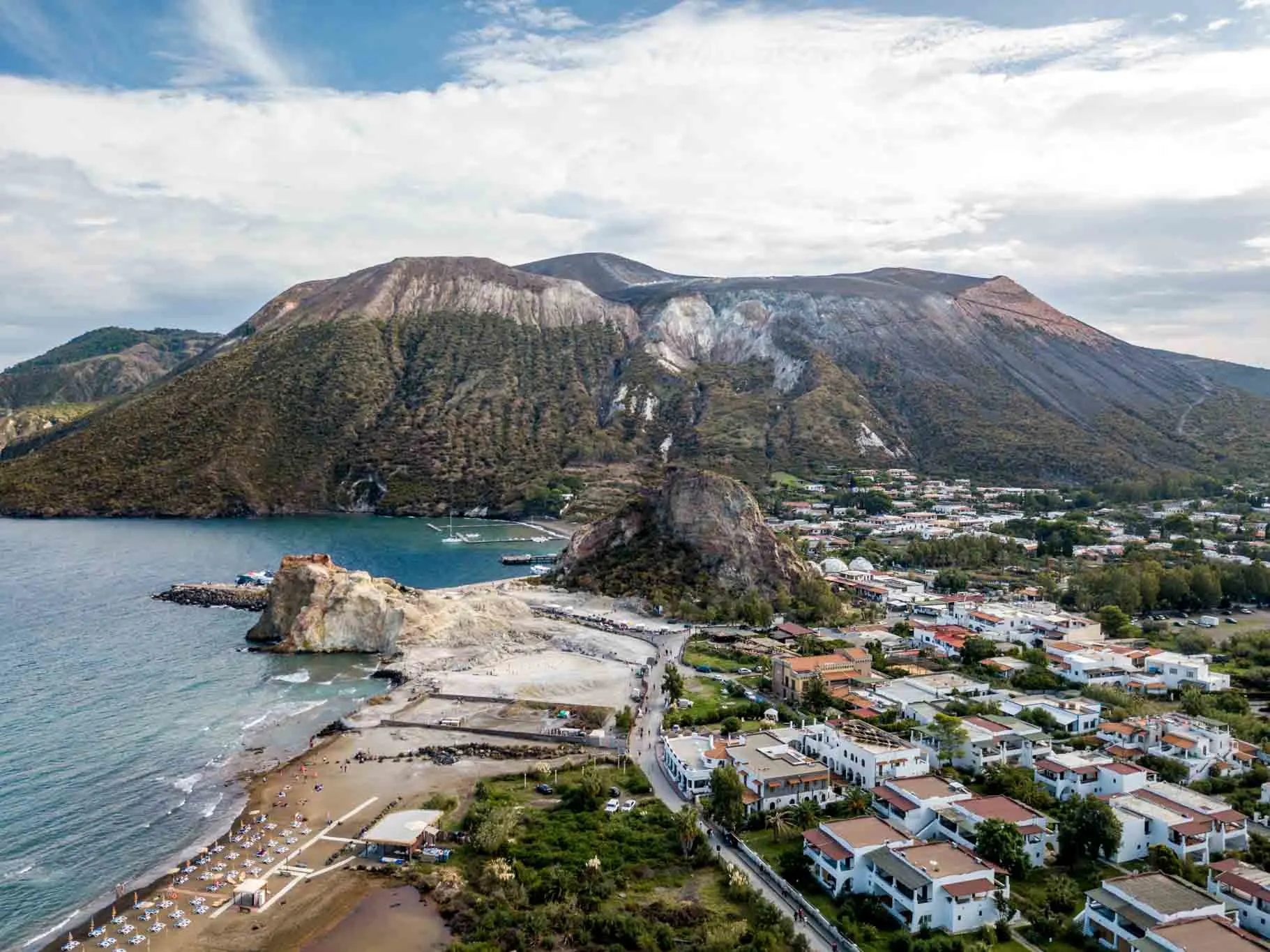
Vulcano, one of the Aeolian Islands, is a must-visit. This curious place is exactly what it sounds like—a volcanic island. In fact, the word “volcano” in English and its equivalents in several other languages come from the name of this small island 16 miles north of mainland Sicily.
We were drawn to visit Vulcano by its mud baths and black sand beaches. The hot springs and mud baths are a result of the volcanic activity, which warms the water and creates a glorious mud pit only about 5 minutes’ walk from the ferry port. Although the air can be a little sulfur-scented, we loved coating ourselves in the therapeutic mud and luxuriating for a bit. (Note that the mud baths are currently closed as plans for a new resort are being developed.)

Nearby is the striking black sand beach, Spiaggia Sabbia Nera. At this scenic spot, the beach curves around a glassy sea. You can rent an umbrella and chair or grab a snack at one of the beach restaurants. The setting is practically perfect in every way.
If you’re feeling more adventurous, trekking up the volcano is a good option. Plus, there’s shopping, wine tasting, and plenty of relaxing to be done as well. We’ve written in more detail about our day on Vulcano, including how to get there.
Where to stay for a Vulcano day trip
The ferry to Vulcano leaves from Milazzo, so that was our base. We loved the stylish and modern Locanda del Bagatto and its wonderful adjoining restaurant (Read reviews and book a room).
Cefalù

Cefalu is one of the most beautiful cities in Sicily. It’s perfect for leisurely strolling and exploring the pedestrian areas and squares. In the summer, this town of 14,000 swells as tourists swarm its beaches. But, in the shoulder season when we visited, it couldn’t be more lovely and calm.
Like Taormina, Cefalu’s setting is dramatic thanks to a massive rock. But, in this instance, the town sits at the base. Cefalu has a friendly seaside that’s one of the best places on the island for lounging and honey-hued buildings full of shops and restaurants great for sampling.

One of the biggest tourist attractions is the Duomo di Cefalu. Along with eight other sites, the Duomo is designated as a UNESCO World Heritage site because of its architecture and amazing mosaics.
Begun in 1131 by the Normans who ruled Sicily at the time, the cathedral looks like a fortress on the outside but houses amazing works of religious art on the inside. Even if you’re not much for visiting churches, these mosaics are worth seeing.
Palermo

Let’s face it—there are a lot of stereotypes about Palermo, and many of them aren’t flattering. We expected grittiness and weren’t sure how safe we would feel in certain places at night. Our expectations weren’t high for the biggest city in Sicily. Palermo challenged every one of our assumptions and left us loving it.
At the crossroads of the Mediterranean, Palermo has been influenced by cultures throughout Europe and North Africa for centuries from the Romans to the Arabs to the Spaniards and beyond. That multiculturalism is evident from the architecture to the food to the inhabitants of Palermo themselves.
Several of the big tourist sites in Palermo are churches, namely Palermo Cathedral and the glittering Palatine Chapel. The Palatine Chapel is the royal chapel of the Norman kings of Sicily and a must see. Commissioned in 1132, it feels like every inch of the great room is covered in gleaming gold mosaic. Every detail is a sight to behold, and when you account for the fact that it’s nearly 900 years old, the effect is amazing.

It’s not all about history, though. Palermo has an amazing food culture, too. The three city markets are filled with people shopping and indulging in the numerous kinds of Palermitan street food. There are also street-side grills and, of course, many delicious restaurants to choose from.
Where to stay in Palermo
Palermo is notoriously challenging to drive in, so we stayed as close to the main coastal road as possible. This made it easy to drive and easy to park, and we were still only a 10-minute walk from the historic city center.
- Check out the charming Palazzo Pantaleo (Read reviews and book a room) and the highly-rated Massimo Plaza Hotel, which is located just across from the famous Teatro Massimo (Read reviews and book a room).
Monreale

Just nine miles (or a half-hour drive—traffic is crummy) from Palermo is Monreale. The cute hilltop town is famous for its Cathedral of Monreale. As with the other cathedrals and churches mentioned in Palermo and Cefalu, this one is part of the collective UNESCO World Heritage Site of Arab-Norman churches. Otherwise, I promise I would not be mentioning another church again.
We really aren’t huge into churches, but the Cathedral of Monreale may be the most spectacular one we’ve ever seen. It has 130 mosaic scenes, 200 carved columns, and a massive 65-foot-tall mosaic of Christ Pantocrator over the altar. The mosaic is estimated to be covered in over 2 tons of gold. It’s spectacular.
A visit to the Cathedral and a quick coffee or meal on the square is absolutely worth a stop.
Segesta
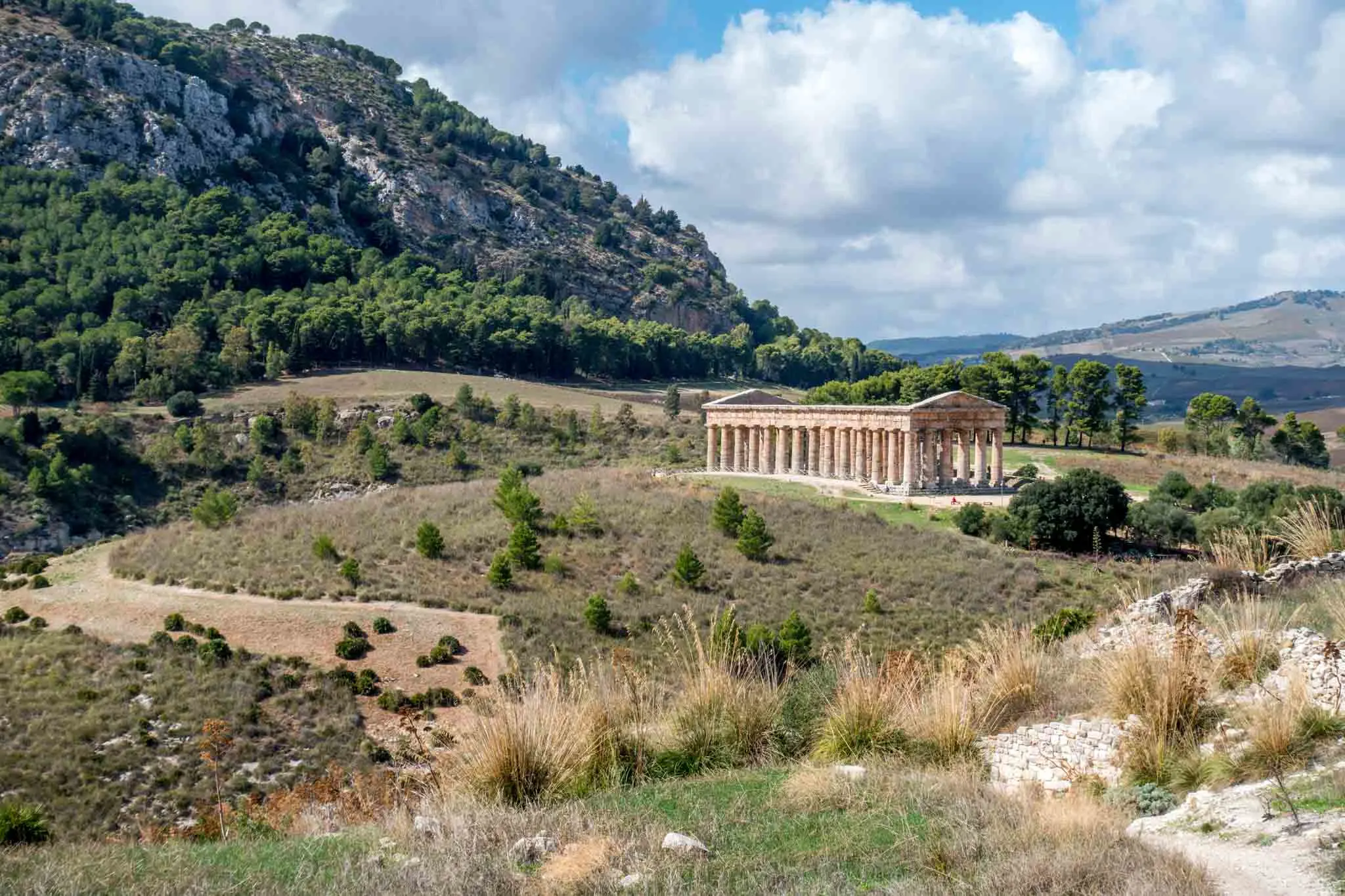
The ruins at Segesta are one of the most evocative ancient sites and places to see on the island.
Segesta was once a major city of the Elymians, an ancient civilization who lived in western Sicily for centuries during the Bronze Age and classical antiquity. The Greeks annihilated the population in 307 BC, but its architecture remained.


Although little of the ancient city survives in the spectacular canyon setting, what’s left is remarkably well-preserved. The Doric Temple at Segesta dates from around 430 BC. Although never completed, its 28 massive columns still stand. On a nearby hilltop (you can take a shuttle or hike up), the 3rd-century amphitheater has spectacular views.
Erice

The approach to Erice is a nail-biting series of switchbacks that send you a half-mile above sea level (it made Lance nervous to drive, which is rare). A medieval town on the top of Mount Eryx, Erice is renowned for its views of the sea and the valley below.
As with many towns in Sicily, Erice was ruled by numerous civilizations over the centuries, including the Elymians, the Phoenicians, the Carthaginians, and the Romans. It was even the center for the cult of Venus. Each culture contributed to Erice’s architecture and layout, leaving bits and pieces in the grey stone town, some of which are still visible.

Erice is known most for three things: incredible pastries at Maria Grammatico’s pastry shop, the views from the city, and its wild weather that can go from sunny to foggy in just a few minutes. Unfortunately, we got a taste of the weather, which means we missed the views. We focused on the pastries instead, sampling Sicily’s best cannoli.
Trapani and Marsala

We visited the towns of Trapani and Marsala for three reasons. The first and most practical reason was that they were on the route as we made our way south toward Agrigento. The reasons we chose these specific towns were because we wanted to see the salt flats of Trapani and to try the wine in Marsala.
At the Trapani salt pans, the ocean water comes right up to the land, just held back by the narrowest of dikes. We were so close that it seemed like a tide or a moderate wave would push the sea over the ledge and right onto the road. Having the water very close (as in Gozo), helps the salt production, as it is pumped up and over into its pans to await evaporation.

Trapani is home to the Museo delle Saline (aka Salt Museum). Its exhibits go into great detail about the process of making salt, and you can see the mill at work on certain occasions. Climbing to the top of the mill provides gorgeous views of the salt flats and the sea, but unless you have an particular interest, the museum is skippable.
Instead, stop for a meal or a drink at the restaurant and enjoy the view. With more time, consider a cruise to the nearby gorgeous Egadi islands for swimming, eating, and exploring.

Just a half-hour away in Marsala, we found the thing we set out for—the town’s namesake golden wine. Some wineries in Marsala offer tours and tastings, but you must book in advance. We were lucky to join a tour at Cantine Pellegrino, one of Marsala’s best and oldest wineries, now in its sixth generation of family ownership.
We learned about grapes that were unfamiliar to us like the white, fruity Inzolia or the sweeter Grillo along with Moscato, one of Lance’s favorites. Inside, we wound our way through exhibits about wine-making and the Pellegrino family history. And then we got to sample three of Pellegrino’s best straight from the giant wooden barrels.
Where to stay in Marsala
- The sleek, comfortable SLO Design House is an ideal spot for exploring Marsala and the surrounding area. You can’t beat the views from the private rooftop lounge (Read reviews and book a room).
- Friendly hosts and a home-cooked breakfast make I Tramonti Sul Mare a great choice (Read reviews and book a room).
Agrigento

The Valley of the Temples in Agrigento is the island’s top tourist site and one of the best places to see ruins. Surrounded by olive groves and almond orchards, the UNESCO-listed site is full of Greek ruins above and below ground.
The Valley of the Temples is known for having the best-preserved Doric temple outside of Greece, and it has a little less scaffolding and fewer cranes than the Parthenon in Athens does right now, too. The archaeological park consists of six temples built between 510 BC and 430 BC.

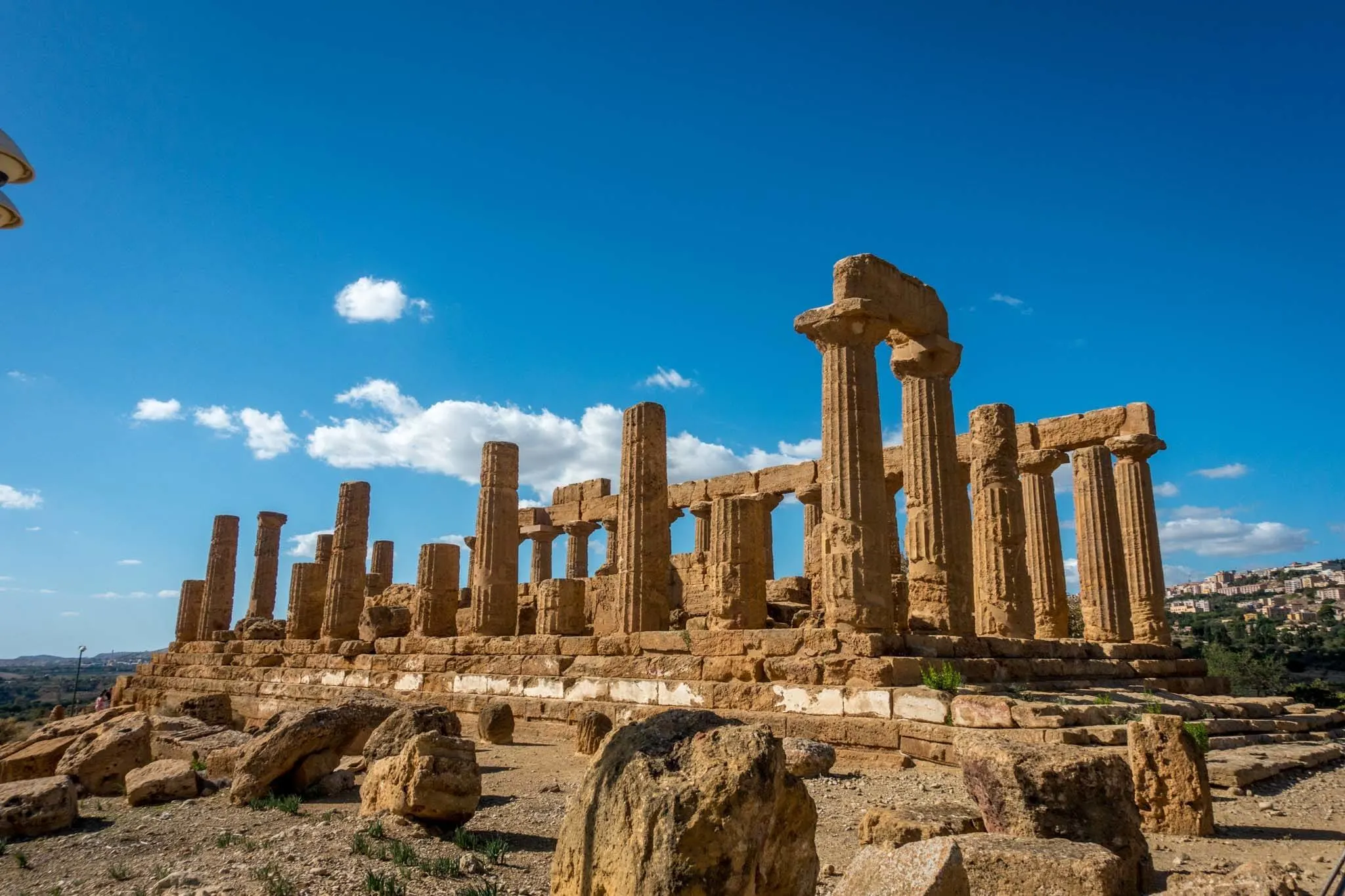
The star is the Temple of Concordia in the middle of the park. Thanks to its location on soft clay and its use as a church and for other purposes, it has survived earthquakes and other types of damage over the centuries.
There’s also the Temple of Juno, the Temple of Heracles, and the remaining three columns of the Temple of Castor and Pollux, among other ruins. The buildings that still stand here make it clear how wealthy the ancient town of Akragas—one of the most impressive cities of Magna Graecia—once was due to its favorable trade agreements and position right on the ocean.

The Valley of the Temples offers different walking tours throughout the day, and you can buy tickets for them when you arrive. We joined a tour exploring the catacombs and death traditions of the people who once called this city home. The descriptions at the attractions are sufficient, but having a tour guide is sometimes nice to understand the site more completely.
Where to stay in Agrigento
Bamboo Luxury B&B in Agrigento was one of the nicest places we stayed. With a spacious room, comfortable seating area, and a terrace for eating breakfast outside, it was practically perfect (Read reviews and book a room).
Catania
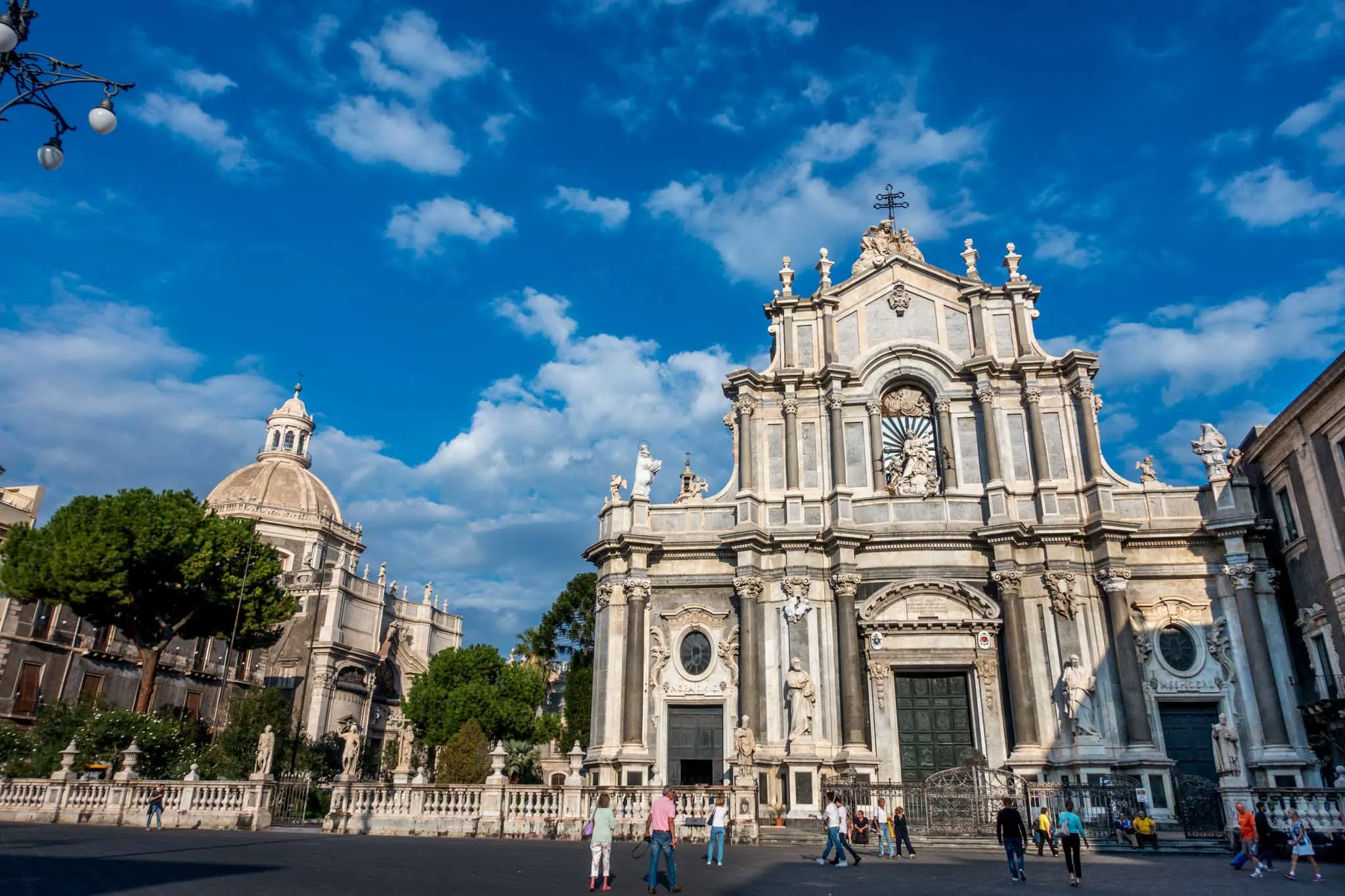
Sicily’s second largest city, Catania was hit by duel disasters—the eruption of Mount Etna and an earthquake—in the late 1600s, which destroyed most of the city. As a result, it doesn’t have the ancient sites you’ll see other places on the island. However, it does have plenty of Baroque buildings and sprawling piazzas as a result of the rebuilding, which have landed it a spot in the UNESCO World Heritage list.
If you’re flying elsewhere in Europe, you’re likely to go through Catania. Take the time for a walking tour through the city. If you love markets like we do, don’t miss the festival of seafood that is the fish market that happens every Monday through Saturday from 7:00am to 2:00pm. Visit the nearby Piazza del Duomo and see the unusual elephant fountain and the Duomo itself. Stop in to one of the hip bars or have aperitivo in a square and watch the city buzz around you.

Driving Tips
Book ahead. Rental car availability can be limited. Booking from a major agency and using this comparison site to find the best deals may help.
Get licensed. The International Driving Permit is required in Italy. Your rental agency may or may not require it to rent the car, but if you run into trouble, you can guarantee the police will want it.
Park carefully. Nearly all parking is on-street parking, if you can find it. If asked by an attendant (even if he doesn’t look official) to pay, you should pay. Parking garages can be found in some bigger cities like Catania, Palermo, and Taormina.
Take your time. It takes a lot longer to get anywhere than you would expect based on distances. Allow lots of extra time to get there.
Enjoy yourself. Try to laugh at wrong turns and smile at the locals. You’ll have an amazing story to tell when you get home.
Laura Longwell is an award-winning travel blogger and photographer. Since founding Travel Addicts in 2008, she has written hundreds of articles that help over 3 million people a year get the most out of their travel. In that time, she has visited nearly 60 countries on 5 continents, often returning to favorite destinations over and over again. She has a deep love of history, uncovering unexpected attractions, and trying all the good food a place has to offer.
In addition to Travel Addicts, Laura runs a site about her hometown of Philadelphia—Guide to Philly—which chronicles unique things to do and places to see around southeastern Pennsylvania. Her travel tips and advice appear across the web.


wayamaya
Thursday 27th of February 2020
Great post. Nice that you mention about the Aeolian Islands. We haven't heard about them and for sure we will visit them next time. We've been in the Southeast part of Sicily but not in all places. Your photos are amazing and inspired us to visit more places in Sicily.
Ida
Wednesday 26th of February 2020
Thanks for a lovely article! We're currently planning a trip and this was very useful. If you had to choose one, or two cities (or north/south), what would you go for? Thanks a lot!
Laura Longwell
Thursday 27th of February 2020
I'm glad you found it helpful! Picking just a couple of cities in Sicily is tough. I would definitely choose to visit Cefalu--we were only there about an hour before we started talking about how we'd like to come back and stay for much longer. After that, I would probably pick Palermo simply due to the volume of attractions there and the ability to easily visit the beach and Monreale from the city.